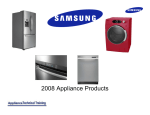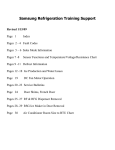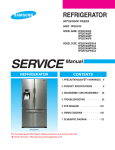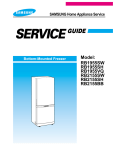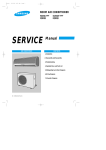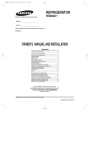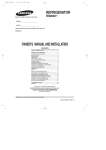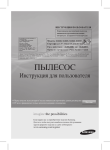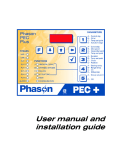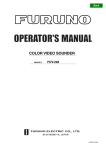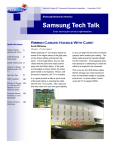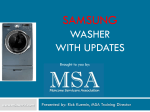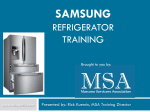Download Samsung DV448 Service manual
Transcript
2008 Appliance Products 1 Table of Contents PAGE DESCRIPTION 3 17 87 97 161 316 329 Support Information Refrigerator Window Air Conditioner Dishwasher Laundry OTR Microwave Electric Range 2 Chapter 1 Samsung Support Information 3 4 Support Contact Numbers • • • • • • • • Customer Service – 1-800-SAMSUNG (726-7864) Authorized Service Centers Tech Assist – 866-797-8736 (account number required) – Hours 9AM – 9PM Eastern Time – 11AM - 4PM Eastern Time Saturdays – Email [email protected] Non Authorized Service Centers – 201-584-0412- Fax service Only Warranty Assistance: 800-849-2198 option 8 Web Site Assistance: 1-201-229-4177 Web Site Assistance [email protected] Training Requests [email protected] Tech Talk Newsletter Subscriptions [email protected] • Global Service Partner Network http://service.samsungportal.com • Login and Password Issues: Elisa Pagliaro [email protected] • GSPN Content Issues: Jim Foster [email protected] Parts can be ordered through: Samsung GPCA Global Parts Center America Parts ordering or backorders 800-634-8276 or you may use: Marcone Appliance Parts 800-482-6022 5 Regional Service Managers Home Appliance Field Service 6 Be Prepared When Calling for Technical Assistance on Appliances Slow Times: 6-9 PM EST M-F; 11-4 EST Sat. For prescreening calls The technical assistance team needs four things when you call: • • • • Your account number Product model number Product serial number Your name Remove the service covers of the equipment under repair and be prepared to take measurements and test components. Please remember, Laundry and Refrigeration products have a letter at the end of the serial number. 7 Ref & Laundry Serial Number Information Model Name Production Line Check Digit 635543CP100160A Pro. Year Y : 2005 A : 2006 Jan L : From 2006 Feb P : 2007 Pro. Month 1~9 : Jan~Sep A : October B : November C : December Model Name 8 Refrigerator Model Number Nomenclature • RS = Side by Side • RF = French Door • RM = Four Door • RB = Bottom Mount Freezer 9 Technical assistance will not be able to help unless you are properly prepared with tools when you are with the product. • Multimeter requirements for appliance calls: – Accurately measure DC voltage to the hundredths of a volt (3.56VDC) from 1VDC to 24VDC with special meter leads or safety pins to read voltages at the small connectors on the main circuit board. – Accurately read resistance from 1 Ω to 200K Ω – Accurately read AC voltage from 16VAC to 240VAC – Replacement meter batteries!!!!!! • Please have an instrument available to accurately measure freezer and refrigerator temperatures. • An Amp Probe or Watt Meter would be an advantage. 10 Know your meter scales Use for Sensor Voltage Tests or 20 VDC scale on some meters Use for Defrost Heater tests 11 REDO Prevention Tips Samsung Electronics is currently focusing on reducing our repeat repairs (Redo). We have prepared the following tips for all of our Service Centers to follow so that we can improve our overall service to our mutual customers. 1. The technician should always talk directly to the customer before each call. Many techs get their idea of what’s wrong via 2nd hand conversation, bring the wrong parts and put it in figuring doing something is better than nothing. This is a bad practice. 2. Ask the customer if there were any other symptoms before the current problem appeared. 3. If you do not see the defect during your visit and you are not sure what the problem is, do not guess on the repair. Confirm the symptom by picture, Technical support, or research on PVI website. 4. Do not submit a claim using EADJ if no adjustments were actually performed because this will contribute to a REDO if a 2nd call is needed. Be sure to properly code the repair. See list of repair codes on the next page which do not affect the REDO rate. 5. If you are 99% sure that one of two possible parts will repair the unit, change both parts. However, only do this when you are sure that this will repair the unit because one of our KPI is amount of parts used. 6. Spend time after the repair burning the part in (at least 20 min) and talk to the customer to make sure they are satisfied with the repair (not going to call back after you leave). 7. Please review your claim submission process to make sure that you are not submitting two claims for the same unit repair at the same time. These are some of the habits of the best technicians in the country. The best technicians also concentrate on having the correct parts in stock by reviewing their weekly usage. If you have any other tips which you have found to be successful in reducing repeat repairs, please send them to your RSM. 12 Repair Codes Excluded from REDO calculation: • • • • • • • • • • • • • CEST: Customer Refuse Estimate CLEA: Cleaning CLEN: Cleaning CUST: Customer Education DTYX: Dirty EXCP: EXCH-Company Policies EXES: EXCH-Excessive Service EXLW: EXCH-By law FACT: Factory Modification HOLD: Waiting for parts INST: Installation ISTL: Installation MACC: Missing Accessory Samsung will pay the minor warranty rate for a customer education call ONE time for each consumer product while under warranty • • • • • • • • • • • • • MISS: Missing MMCH: Mis-Match NPFD: No problem found NPRB: No problem found PANT: Paint RCON: Reconnect RECH: Recharge RECO: Reconnect RSTU: Reseat SCHX: Scratch SPEC: Specification measurement WSUP: Wrong Setup RCLL: Recall If a initial warranty claim is submitted with one of the above repair codes and another repair is submitted within 90 days the service center is NOT charged with a REDO 13 Quick Document Search 1. From the Main Menu Select “Warranty/Parts” 2. Type in the Model Number in the Left Hand Search Field HLP5063 3. Click on the Magnifier Button 4. Manuals and Bulletins are displayed with appropriate hyperlinks 14 Parts List Search To search for the Bill of Materials (BOM) 1. Click Warranty/Parts Tab 2. Order management -> Parts Information -> Parts list by Model 3. Type in the Model Code and click Search 15 Bill of Materials Search Tip 1. Click on the correct model code (Check country list on right to make sure it is the right model) 2. Check mark the parts you need and Click CREAT P/O or ADD TO CART 3. Service bulletins and tips can be found for the specific part 16 Chapter 2 Refrigerator Technology 17 Dual Evaporator with TDM valve The Time Divided Multi-cycle (TDM) System (Stepper Valve) is used to switch refrigerant flow in the 4 Door (RM25*) and French Door (RFG29*). This improves temperature control and energy efficiency. Quad Cooling RM Model Twin Cooling RS/RF/RB Models 18 Inverter Compressor Inverter compressors offer energy savings not available in a standard compressor 19 Refrigerant Path Compressor Sub-condenser Hot Pipe Dryer Step valve R Capillary Tube R/CR Evaporator F Capillary Tube C/CF Evaporator Suction Pipe C Capillary Tube Compressor 20 Chapter 3 Refrigerator Troubleshooting 21 Refrigeration Troubleshooting • The Forced Operation Mode is a very valuable troubleshooting tool for testing compressor operation, fan operation and defrost operation. • Forced Freeze Mode • The compressor is started without the 5 minute delay • You can check the compressor voltage at the main PCB in this mode. • You can accurately check defrost sensor voltages in this mode • All fans will be turned on in this mode, to allow voltage testing. The door switches still control the fan operation. 22 Refrigeration Troubleshooting • Forced Freeze Mode Inverter Compressors • The compressor is started without the 5 minute delay • You can force the three speed options of this compressor • You can accurately check the temp and sensor operation • All fans will be turned on in this mode, to allow voltage testing. The door switches still control the fan operation. 23 Refrigeration Troubleshooting • Forced Defrost Operation • Standard compressor models can activate the Fridge defrost only, or both the Fridge and Freezer defrost. • Inverter compressor models activate all heaters at once. • In the Forced Defrost Mode the defrost sensor still controls the heater operation. When defrost is activated the main PCB will turn over defrost control to the sensor in about 90 seconds. If the defrost sensor reads a temperature above the shut off point it will tell the main PCB to turn off the defrost voltage. • Even when the defrost is turned off the unit will stay in the forced mode for up to 24 hours. 24 Refrigeration Troubleshooting • Selecting the Forced Modes • When the two buttons are pressed together to enter the Forced Modes you must wait for the beep and the display to go blank. You then have 8 seconds to press the Freeze button to activate the Forced Freeze Mode. Once you are in this mode, press the Freeze button to advance to the next function. • Depending on the model, there are from two to four Forced Modes. You must always wait for the beeping to start before advancing to the next mode, if you wait over 8 seconds to press the Freeze button, you will have to start over again. If you lose track of where you are in the Forced Modes, unplug the unit and start over. 25 Forced Operation and Test Mode Test Mode Press both buttons simultaneously for 8 seconds! Display Code FF RD FD -- Function Forced Compressor Run Forced Refrigerator Defrost Forced Freezer Defrost Test Mode active Press any button one more time to cancellation Forced Mode Cancellation Forced Forced Operation Operation Press any button One time at the Test Mode Forced ForcedDefrost Defrost for forFridge Fridge Press any button One time at the Forced Operation Forced ForcedDefrost Defrost for forboth both compartment compartment Press any button one more time at the Forced Defrost for Fridge 26 Forced Operation For various refrigerator panels Press both buttons simultaneously for 8 seconds! Cancellation, unplug unit Press Freezer button One time at the Test Mode to Force Compressor Forced Forced Compressor Compressor Wait 5 seconds between button pushes Press Freezer button Second time for Forced Defrost of Fridge Forced ForcedDefrost Defrost for forFridge Fridge Press Freezer button a third time to Force Defrost for Fridge & Freezer Forced ForcedDefrost Defrost for forboth both compartment compartment 27 RFG29* Series Inverter Compressor Forced Mode For Test Mode Press both buttons simultaneously for ~15 seconds! Press Freezer button One time at the Test Mode to Force each Compressor test Forced Forced Compressor Compressor High High Forced Forced Compressor Compressor Mid Mid 3600 RPM 2450 RPM Forced Forced Compressor Compressor Low Low Wait 5 seconds between button presses 2050 RPM Simultaneous manual defrost (fresh food and freezer compartments) function Press Freezer button a 4th time to Force Defrost for ALL Compartments Forced ForcedDefrost Defrost for for ALL ALL compartments compartments 28 RM257*** Series Inverter Compressor Forced Mode For Test Mode Press both buttons simultaneously for ~15 seconds! Press Freezer button One time at the Test Mode to Force each Compressor test Forced Forced Compressor Compressor High High Forced Forced Compressor Compressor Low Low ~ 3600 RPM ~ 2450 RPM Forced Forced Compressor Compressor Mid Mid Wait 5 seconds between button presses ~ 2050 RPM Simultaneous manual defrost (all four compartments) function Press Freezer button a 4th time to Force Defrost for ALL Compartments Forced ForcedDefrost Defrost for for ALL ALL compartments compartments 29 Forced Mode for Single Evaporator units Use Freezer Key as a Test Key Wait 5 seconds between button pushes RS26/2530** 30 Refrigeration Troubleshooting • The Diagnostic Mode is the most valuable troubleshooting tool you have for troubleshooting a refrigerator. When you are at the product this is the first test you should do. • When a Samsung refrigerator is powered up if performs a Self Diagnosis, if an open or shorted sensor is detected it will lock the display and flash the code in the display. The refrigerator may have no operation, or operate in the emergency mode. Other faults detected will not lock the display or stop operation. • To restart operation put into Manual Diagnostic Mode. • Sensors that are off value, but not shorted or open, will not bring up a fault code. Note: accessing this function resets ALL programming and error codes. 31 Refrigeration Troubleshooting • To enter the manual Diagnostic Mode you must press and hold two buttons, and hold them until the display stops blinking and beeps. • Fault code display for all models that have temperature numbers in the display: – Each 8 is made up of 7 segments, each of those segments is a possible fault code. • If there are no faults, the display will be blank or have all four (8888) showing. • On single evaporator units, no number display, lines or symbols will light up for faults. • On all models the display will come back to normal in about 12 seconds 32 Refrigeration Troubleshooting • A Sample fault code would be this is an example of an Ice Maker Sensor failure. • Things that can happen with this fault. • After a power failure the unit would be “dead”, lights work and blinking this code. • The Ice Maker is not making any ice • The Ice Maker is dumping partially frozen cubes • If you see the fault below, ignore it. This is a modem communication error not applicable in the US. 33 Self Diagnostics Press both buttons simultaneously for 8 seconds If a corresponding LED flickers, it means an abnormality of a sensor or component. 34 Self Diagnosis Hold Buttons until display stops blinking and beeps, then release and read fault codes. Various refrigerator panels are shown 35 Error Code Display Pt 1 Error items for self-diagnostics Codes are shown for example, a full list of codes for the specific product is available in the service manual NO Error items 1 I/M-SENSOR 2 R-SENSOR LED TROUBLE Ice maker sensor measures open or shorted Refrigerator sensor measures open or shorted DEFROSTING 3 SENSOR OF R COMPARTMENT Refrigerator Defrost Sensor measures open or shorted 4 Refrigerator fan motor stuck or spinning to fast R-FAN ERROR Temperature Sensors are Negative Temp. coefficient measuring between 2.2 K and 100K Ω 36 Error Code Display Pt 2 Error items for self-diagnostics NO Codes are shown for example, a full list of codes for the specific product is available in the service manual 5 7 8 Error items LED TROUBLE I/M FUNCTION ERROR Ice maker did not return to level after an ice harvest, this is displayed after three attempts R-DEFROSTING ERROR Refrigerator Compartment defrosting heater- electric wire cut, short-circuit, contact failure, missing of sensor housing, or defective temperature fuse/bi-metal. The defect is also displayed if defrosting is not finished until after continuous heating over 80 minutes. CR-SENSOR CR Compartment Sensor Error- This can be an Electric wire cut, short-circuit, contact failure, or missing sensor. This can also be caused by a temperature reading > 122° or < -58 . 37 Error Code Display Pt 3 Error items for self-diagnostics Codes are shown for example, a full list of codes for the specific product is available in the service manual LED TROUBLE NO Error items 9 DEFROSTING SENSOR OF CR COMPARTMENT CR compartment Defrost Sensor Error- This can be an Electric wire cut, short-circuit, contact failure, or missing sensor. This can also be caused by a temperature reading > 122° or < -58 . 10 DEFROSTING SENSOR OF CF COMPARTMENT CF compartment Defrost Sensor Error- This can be an Electric wire cut, short-circuit, contact failure, or missing sensor. This can also be caused by a temperature reading > 122° or < -58 . CR-DEFROSTING ERROR CR Compartment defrosting heater- electric wire cut, short-circuit, contact failure, missing of sensor housing, or defective temperature fuse/bi-metal. The defect is also displayed if defrosting is not finished until after continuous heating over 80 minutes. CF-DEFROSTING ERROR CR Compartment defrosting heater- electric wire cut, short-circuit, contact failure, missing of sensor housing, or defective temperature fuse/bi-metal. The defect is also displayed if defrosting is not finished until after continuous heating over 80 minutes. 11 12 38 Error Code Display Pt 4 Error items for self-diagnostics Codes are shown for example, a full list of codes for the specific product is available in the service manual NO Error items 13 WATER HEATER ERROR 14 EXT-SENSOR 15 F-SENSOR 16 F-DEF-SENSOR LED TROUBLE Water Reservoir Heater measures open Ambient Temperature Sensor reads open or shorted Freezer Temperature Sensor reads open or shorted Freezer compartment Defrost Sensor Error- This can be an Electric wire cut, short-circuit, contact failure, or missing sensor. This can also be caused by a temperature reading > 122° or < -58 . 39 Error Code Display Pt 5 Error items for self-diagnostics NO Codes are shown for example, a full list of codes for the specific product is available in the service manual Error items LED TROUBLE Freezer fan motor stuck or spinning to fast 17 F-FAN ERROR 18 C-FAN ERROR 19 CF-SENSOR CF Compartment Temperature Sensor reads open or shorted F-DEFROSTING ERROR Freezer Compartment defrosting heater- electric wire cut, shortcircuit, contact failure, missing of sensor housing, or defective temperature fuse/bi-metal. The defect is also displayed if defrosting is not finished until after continuous heating over 80 minutes. 20 Compressor fan motor stuck or spinning to fast 40 Error Code Display Pt 6 Error items for self-diagnostics Codes are shown for example, a full list of codes for the specific product is available in the service manual NO Error items 21 CF-FAN ERROR 22 CR-FAN ERROR 24 ICE PIPE HEATER ERROR LED TROUBLE CF Compartment fan motor stuck or spinning to fast CR Compartment fan motor stuck or spinning to fast Ice Maker Fill line heater measures open 41 Error Code Display Pt 7 Error items for self-diagnostics Codes are shown for example, a full list of codes for the specific product is available in the service manual NO Error items 25 Uart COMMUNICATION ERROR 26 27 L↔M COMMUNICATION ERROR P↔M COMMUNICATION ERROR LED TROUBLE This error is not applicable if you encounter this error during diagnostics ignore it Bad communication between LOAD↔MAIN MICOM Bad communication between LCD Panel ↔MAIN MICOM 42 2008 French Door Refrigerator Error Codes Codes are shown for example, a full list of codes for the specific product is available in the service manual 43 2008 French Door Refrigerator Error Codes Codes are shown for example, a full list of codes for the specific product is available in the service manual 44 Defrosting Troubleshooting Check for any fault codes in the manual Diagnostic Mode Frozen Evaporator YES Ask the Consumer if there has been water or ice build up on the bottom of the Fridge compartment or the floor. Check for frozen drain and/or open drain heater NO Frozen Evaporator YES Is the Defrost Heater Open? Replace heating element or evaporator NO Frozen Evaporator Is the Door gasket or door flap leaking? YES Replace door gaskets NO Frozen Evaporator Check for cracks in liner or air leaks 45 Testing Defrost Circuits Access the main PCB for voltage/resistance testing – – – – With the compressor running test the sensors Enter Forced Mode Defrost Measure the heater voltage Remove the power and heater connector and check the heater circuit resistance • Defrost Sensor – The sensor shuts off heater At 50 in Freezer, 63 in Fridge – If the sensor is bad it may shut off the defrost circuit in a few minutes or not start, causing ice build-up, or it could lock up in defrost mode and become a total no cool. Note: A defective sensor may check OK at room temperature, test at operating temperature only. 46 Defrosting Troubleshooting Part 1 • Defrost Sensors – Testing: Check the DC voltage across both evaporator defrost sensors, with the compressor running. They should read less than a tenth of a volt difference, as they are both on the same refrigerant line. They usually read ~ 3.7VDC, after the compressor has been running for about 10 minutes. You may find one reading about 30 to 50 degrees off (lower VDC - higher temp), if so replace it. • Alternate Sensor Testing Make ice slurry. To do this, fill a cup with ice (preferably crushed), then add water and a teaspoon of salt to make a slush. Mix thoroughly and allow to sit for 2 to 3 minutes. This will give you a 32 reference. Lower the sensor into the mixture and leave for about 1 minute, check the resistance. It should be very close to 13,300 Ω. Before reinstalling the sensor, be sure to rinse it with fresh water and dry it. 47 Defrosting Troubleshooting Part 2 Enter the Forced Mode per instructions • Check heater circuit amperage at the Main PCB or A/C line; look for ~1.2 amps for the Fridge and ~2.2 amps for the freezer or 3.4 amps total. NOTE: If compartment is warm, you only have about 90 seconds to test. • Freezer - Check service manual for connector and wire color code for the model being serviced. • Fridge - Check service manual for connector and wire color code for the model being serviced. • Low Current draw? Check individual defrost circuits, if one is low check for open defrost heater • No Current draw? Check voltages and resistances next. 48 Defrosting Troubleshooting Part 3 Enter the Forced Mode per instructions • Check the heater circuit voltage at the Main PCB; should be 120VAC for Freezer and Fridge. NOTE: If compartment is warm, you only have about 90 seconds to test. Listen for the relay closing then check the heaters. • Freezer Defrost Heater - Check service manual for connector and wire color code for the model being serviced. • Fridge Defrost Heater - Check service manual for connector and wire color code for the model being serviced. • No AC Voltage? Change Main PCB 49 Defrosting Troubleshooting Part 4 Heater circuit resistance - Unplug the refrigerator. Remove the defrost heater connector from PCB. • Freezer - Check heater circuit resistance at the Main PCB, look for 35–50 Ω average. • Fridge - Check heater circuit resistance at the Main PCB, look for 60-95 Ω average. • Freezer & Fridge - If resistance is around 2600 Ω, ThermoFuse (Bi-metal) is good, Defrost heater is open. • Open Circuit - Check the Thermal Fuse (Bi-metal), Heater and Connectors 50 Defrosting Troubleshooting Example of a 2600 Ω heater 51 Defrost Error Symptoms NOTE: Evaporator covers may break if removed while frozen as they are plastic, replace if damaged. • Ice build up in either the freezer or refrigerator compartment can be caused by a blocked drain. It is possible that the drain is not being defrosted by the heaters enough to properly clear the drain and pass the melted water into the catch pan. • Noise from the refrigerator/freezer fan or weak cooling. Noise disappears when the customer opens door. The defrost sensor, heater, thermal fuse/bimetal device are OK but ice is built up in the drain area of evaporator cover. 52 Defrosting Error Causes • The heat from the defrost heater does not transfer to the evaporator drain • The Styrofoam around the evaporator cover absorbs moisture and frost begins to form on the evaporator, defective evaporator cover. • During the defrost cycle, the frost melts and drips down to the drain where it becomes frozen again. • Ice blockage in the drain grows larger with every defrost cycle. • Because of the growing ice block, cooling efficiency diminishes at a growing rate and eventually blocks the fan blades. • Self diagnostics will eventually show a fan error. 53 Defrost Circuit Modification • Metal clips “A” and “C” can be placed on both the evaporator cover and the evaporator. The metal clips will touch and transfer heat more efficiently from the defrost heaters to the drain preventing ice build up. Part numbers for these parts are as follows: A: DA61-03502A PLATE-DRAIN INS EVAP, REF C: DA61-03585A FIXER-EVAP REF 54 Compressor Controller board connector arrangement and detail explanation (RM257AB*) Forced Modes: 12VDC 5VDC Ground Compressor RPM FF1 - Compressor high speed - 2.7 amps FF2 - Compressor low speed - 1.6 amps FF3 - Compressor medium speed - 2.0 amps FD - All defrost elements on - ~ 4.0 amps NOTE: FF2 & FF3 could be reversed. Compressor not running Check for 5 minute delay -- Not in delay Force Operation -- If no operation, disconnect CN03 (SMPS PCB) and check resistance to the windings. ~10 Ω Comp windings OK -- Disconnect CN02 (SMPS PCB), check resistance to overload Overload OK -- Replace Main PCB and Inverter PCB Compressor OLP 55 Model: RFG294 **, RFG295**, RFG299** Compressor Troubleshooting CN04 VDD VSS RPM FB CN01 POWER(115VAC) CN03 U V W CN02 OLP Compressor not running Forced Modes: Check for 5 minute delay -- Not in delay FF1 - Compressor high speed - 2.7 amps Force Operation FF2 - Compressor medium speed - 2.0 amps If no operation, disconnect CN03 (SMPS PCB) and check FF3 - Compressor low speed - 1.6 amps resistance to the windings. ~ 10 Ω FD - All defrost elements on - ~ 3.4 amps Comp windings OK Disconnect CN02 (SMPS PCB), check resistance to overload Overload OK Replace Main PCB and SMPS PCB 56 Chapter 4 Common Refrigerator Service Issues 57 No Ice - Flex Tray I/M • • • • • For the ice maker to operate properly, water pressure between 20 and 125 PSI is required. A quick test of water pressure would be filling a 6 Oz paper cup in less than 10 seconds. If the internal water filter is clogged, the water pressure to the icemaker will be reduced. The foreign matter at the water supply valve near the icemaker can also reduce the water pressure. Additionally, low water pressure at the fill tube can be caused by a defective fill tube heater. If the tray seems to be filling completely but the unit never harvests, verify the operation of the Icemaker sensor in the tray. Normally the unit harvests when the sensor reads approximately 1.5 for 5 minutes. The sensor should read about 3.7VDC at the main board connector when the cube temperature is 1.5 . After the fill, the sensor will read water temp, 1.5 to 2.2VDC. Remember, using frame ground might produce inaccurate values; instead use the DC ground on the PC board. If this value is incorrect the sensor is suspected to be defective. You can also verify the operation of the harvest motor by pressing the black test unit on the motor housing near the back of the assembly. Is the freezer not dropping below 10 ? Make sure the Freezer defrost circuit is working properly and the evaporator and condenser fans are working correctly. Inspect condenser coil for air blockage. 58 Slow Ice - Flex Tray I/M • • • • This problem is usually caused by a defective sensor or low water pressure. The I/M sensor will delay the time by adding extra fills if the water pressure is low. Also check the operation of the freezer, if the freezer temperature is above 1.5 , ice production will be delayed. This can also be caused by a problem with the freezer air vent, make sure the air duct near the ice maker is not restricted. If the unit is on an R/O water system, water pressure may be to low for consistent ice production. Is there any frost in the freezer compartment? Excessive frost could mean warm air leaking into the compartment warming the top of the freezer preventing the ice maker sensor from maintaining the necessary 1.5 to harvest. • Check for ice chute failure, a leak at ice maker fill tube, an air leak around defrost water drain by evaporator coil, cracks in liner or a bad door seal. Finally make sure the most updated version of Ice maker kit has been installed. The ice maker designs in many models have been updated for better performance. Check GSPN for any related service bulletins regarding Ice-maker changes. 59 Shattered Ice Cubes - Flex Tray I/M • • • • • • When all ice shatters it's because of a bad tray or harvesting at a temp that is too cold (lower than 1.5 ), in some areas hard water issues that can also cause shattered cubes. The temp in the freezer should not have any effect on this issue, as long as it’s below 1.5 , as a properly installed sensor will not read the freezer temp, only the water/ice temp. Check the Ice tray for defects in the plastic. Impurities or hard water can cause the plastic to become rough and inhibit the ice falling from the tray during the twisting. If this is the case, replace the tray assembly. It is possible to get ice too cold. Ice that is too cold will shatter during harvest. This can be from the (1) sensor not reading the correct temp (2) the sensor not mounted correctly (3) by programming the icemaker offset value to a lower number (4) the board not understanding the reading. To check the sensor you must check the tray temp (not air temp) and compare it to the sensor reading. The sensor should read about 3.7VDC at the main board connector when the cube temperature is 5 degrees. After the fill the sensor will read water temp 1.5 to 2.2VDC. To clear offsets, put unit into Diagnostics mode. Please note, some shattering is normal for a flex tray icemaker, especially if the Ice Off feature was used recently. 60 Service ConcernsHeat Release I/M • • • • Troubleshooting Observations Is there any frost in the freezer compartment? Excessive frost on the evaporator coil will either coat the coil enough to warm the air to 32 to supply the ice room or block the air duct completely to the ice room. Make sure the Freezer defrost circuit is working properly and the freezer and ice room compartments are sealed properly The consumer complaint could be “it only makes ice once or twice a day” The Ice maker will harvest within a few hours of the freezer defrost cycle, when the evaporator is frost free. As the frost builds up on the evaporator again the ice maker will stop as the temperature is too warm. Ice making will stop until the next defrost cycle completes which will be 12 to 23 hours later. This is a defrost error not an icemaker error. Check the freezer door seal, ice room door seal and the freezer defrost heater. 61 Service Concerns – Heat Release I/M • Is the Ice Bucket locked firmly in position? • Try to move the bucket, when locked in place, any movement would mean that one of the locks is not latched. This will cause warm fridge air to enter the ice room and stop ice production. • Temperature checks (Actual) • The Back of Ice Room should measure 0 to 6 when making ice • The Back of Freezer compartment should measure -4 to +3 62 Heat Release Ice Maker - Troubleshooting • Voltage tests • The Ice Room Sensor voltage should match the actual ice room temperature; refer to the sensor voltage/ temperature chart in the service manual. • The Freezer Sensor voltage should match the freezer temperature and also be close to the actual ice room temperature, refer to the sensor voltage/ temperature chart in the service manual. If the bucket is full the Ice Room temperature should be around 24 . 63 Heat Release Ice Maker - Troubleshooting • The Freezer Defrost Sensor Voltage should be 0 to -17 , with the compressor running, to show no frost/ice buildup and good operating system, refer to the sensor voltage/temperature chart in the service manual. • The Ejecting Thermistor should not measure below 17 , unless the bucket is full, as it should harvest at 18 . If Ejecting Thermistor measures actual ice room temperature, and the bucket is not full, it would mean that the I/M is not harvesting. If there has been a recent harvest, the thermistor might measure up to 50 as the mold heater and fresh water has warmed the sensor. 64 Heat Release Ice Maker - Troubleshooting • If any of the sensors measure incorrectly replace the defective sensor • The Ice Room Fan should read around 7 to 9 VDC when it is running. Be sure to defeat the door open switch when testing the fans. You can force the fan to turn on by putting the unit into the Forced Freeze mode. • If the I/M Thermistor reads below 18 after 38 minutes and there is no harvest replace the main PCB 65 RF267**, RF26VAB** Not all Connectors and pins used on all models CN73 A/C Load 1-(CN70-1) Cube Solenoid (Yel/Red) RF267 3-(CN70-1) Auger Motor (Pink/Red) RF267 5-(CN70-1) Dispenser Valve (W/Blk-Red) RF267,266 7-(CN70-1) Ice Maker Valve (Vio/Red) 9-(CN70-1) Ice Cover Route (Brown/Red) RF267 CN71 1-(CN70-1) R Lamps (Blue/Red) 3-(CN70-1) F Lamp (Vio/Red) 5 Common N (Gray) 7-(CN70-1) Comp (SkyBlue/Red) 9 Heater Common (Org) CN70 1 Common Line L (Red) 3-(CN71-5) Disp Heater (Black/Gray) (RF267) 5-(CN71-5) French Heater (Yel/Gray) 7-(CN71-9) R Defrost (White/Orange) 9-(CN71-9) F Defrost (Brown/Orange) CN72 (RF267 only) 1-(CN70-1)Ice Maker Motor (Brn) 3-(CN70-1)Ice Maker Heater (Wht) CN91 Pantry Room Damper 1-2 Damper Heater 12VDC (Blk/Brn) 3-4 Damper Motor (White/Blue) 5-6 Damper Motor (Yel/Red) CN10 Low Volt Power 1-3 5VDC (Red/Black) 5-3 12VDC (Yel/Black) CN90 Ice Maker (RF267 only) 4-8 Eject Sensor (White/SkyBlu) 5-8 Test Switch 5VDC (Gry/SkyBlue) 6 Full Switch (Blue) 7 Horizontal Switch (Violet) 8 Ground (Sky/Blue) CN78 4-5 Water Tank Heater (Brn/Blk) RF267 6,7,8 Pantry Display 9-11 +12vdc (Blue/White) 10-11 +5vdc Switch input (Vio/White) CN50 Display 4-6 +12 VDC (Org/Pink) 5-6 +5 VDC (Yel/Pink) 8-(CN75-1) Water Switch (Blue/Red) RF266 CN30 Sensors & Switches 1-5 Freezer Dr Switch (Black/Gray) 2-(CN50-7) R Door Switch (Vio/Gray) 3- (CN75-1) F Sensor (Red/Gray) 4-(CN75-1) F Def Sensor (Org/Gray) 6-(CN75-1) R Sensor (White/Gray) 7-(CN75-1) R Def Sensor (SkyBlu-Gry) 8-9 Pantry Sensor (W/Black-Gry) CN75 F, R, C Fans 2-1 F Fan (Yel/Gray) 3-1 R Fan (Org/Gray) 4-1 C Fan (S/Blu-Gry) 5 F Fan FG (Black) 6 R Fan FG (Brown) 7 C Fan FG (Red) CN32 Sensor 1-4 Ambient Sensor (White/White) 2-(CN75-1) 5VDC to I/M (Red/Gray) RF267 3-(CN75-1) Ice Room Sensor (Org/Gray) RF267 CN76 Ice Room (RF267 only) 1-(CN75-1) Ice Room Fan (Black/Gray) 2 Ice Fan FG (Brown) 3-(CN75-1) Ice Bucket Switch (Red/Gray) 66 Model : RFG 294 **, RFG295**, RFG299** Not all Connectors and pins used on all models CN74 A/C Load 1-(CN70-9) Cube Solenoid (Yel/Red) 3-(CN70-9) Auger Motor (Pink/Red) 5-(CN70-9) Dispenser Valve (W/Blk-Red) 7-(CN70-9) Ice Maker Valve (Vio/Red) 9-(CN70-9) Ice Cover Route (Blue/Red) CN71 1-(CN70-9) R Lamps (Blue/Red) 3-(CN70-9) F Lamp (Violet/Red) 9 Heater Common (Orange) CN73 1-(CN70-9) I/M Heater (Brn/Red) 3-(CN70-9) I/M Motor (Wht/Red) CN76 F, R, C Fans 2-1 Ice Room Fan (Blk/Gry) 3-1 F Fan (Yellow/Gray) 4-1 R Fan (Orange/Gray) 5 C Fan (SkyBlue/Gray) 6 Ice Room Fan FG (Pink) 7 F Fan FG (Brown) 8 R Fan FG (Red) 9 C Fan FG (Blue) CN31 Sensor 1-4 Ambient Sensor (White/White) 2-(CN90-8) 5VDC to I/M (Red/SkyBlu) 3-(CN76-1) Ice Room Sensor (Org/Gray) CN78 Lamp/Veg LED 4-7 +13VDC (Red/Gray) CN77 Stepper Motor 1 +13VDC (Red) CN30 Sensors & Switches 1-5 Freezer Dr Switch (Black/Gray) 2-(CN50-7) R Door Switch (Vio/Gray) 3-(CN76-1) F Sensor (Red/Gray) 4-(CN76-1) F Def Sensor (Org/Gray) 6-(CN76-1) R Sensor (White/Gray) 8-(CN76-1) R Def Sensor (SkyBlu/Gry) 9-(CN76-1) Pantry Sensor (W/Blk-Gry) CN91 Pantry Room Damper 1-2 Damper Heater 12VDC (Blk/Brn) 3-4 Damper Motor (White/Blue) 5-6 Damper Motor (Yel/Red) CN90 Ice Maker 4-8 Eject Sensor (White/SkyBlu) 5-8 Test Switch 5VDC (Gry/SkyBlu) 6 Full Switch (Blue) 7 Horizontal Switch (Violet) 8 Ground (Sky Blue) CN70 1-11 Disp Heater (Black/Gray) 3-11 French Heater (Yel/Gray) 5- (CN71-9) R Defrost (Wht/Org) 7- (CN71-9) F Defrost (Brn/Org) 9- L1 (Red) 10- N (Gray) CN51 Pantry Room 7-5 +13VDC (Blue/White) CN75 To Comp Inverter Board CN50 Display 4-6 +13 VDC (Orange/Pink) 5-6 +5 VDC (Yellow/Pink) 8-6 Ice/Water Switch (Blue/Pink) 9-6 Ice Rte Switch 1 (Vio/Gray) 10-6 Ice Rte Switch 2 (White/Gray) CN79 1-2 Photosynthesis Module (Blk/Brn) 10-6 Water Tank Heater (White/Pink) 67 Common Defrost Problems Evaporator frozen, solid ice • Fridge – Bad evaporator cover, open drain heater, add Fixer and Plate, or blocked drain. • Freezer – Open drain heater, bad evaporator cover, add fixer and plate, or blocked drain Evaporator frozen, all frost • Fridge or Freezer – Bad defrost sensor, open thermal fuse, bad main PCB, open defrost heater • Ice Chute Flapper not Sealing properly 68 Defrost Service Single Evaporator Models • Frost/Ice forming on the evaporator cover and blocking fan and air tunnel to fridge. – Install Repair Kit for Serial Number range: up to **42BL3***** Units manufactured before April of 2006 For model RS2630 – Check for ice chute failure, leak at ice maker fill tube, air leak around defrost water drain by evaporator coil, cracks in liner, or door seal on fridge or freezer. – Excessive door openings, doors left open for long periods, hot foods put in fridge Evaporator frozen, solid ice • Blocked drain Evaporator frozen, all frost • Bad defrost sensor, open thermal fuse, bad main PCB, open defrost heater 69 No Cool Service Issues Both Compartments • • • • Unit locked in defrost mode Compressor relay failure on main PCB Failure of both defrost circuits No sealed system charge Fridge • • • Failure of defrost circuit Evaporator fan failure Door switch failure Freezer • • • • Failure of defrost circuit Evaporator fan failure Door switch failure Low sealed system charge 70 Service Access • Disassembly of Quattro Cool Evaporator Covers, both access the same way 71 Chapter 5 Refrigerator Installation and Door Removal For additional installation details see the accompanying 2008 Installation DVD 72 Water Connection 1 2 - Insert the plastic water pipe hose to the existing water source and fix it with compression hardware. If there is no existing icemaker water line consult a licensed plumber. Connect Water Pipe Hose - Check if there is any water leakage at the connection areas and if the hose is being kinked. When there is water leaking, try connecting again. Secure the Water Pipe Tube - With a C/F clip, fix the water pipe hose to the refrigerator wall. Make sure that the water pipe hose is not kinked or damaged when dressing the excess water pipe. Example of Bad Installation Coiled hose, no backup tube, water hose touching the floor. Example of Good Installation No coiled hose, backup tube added, water hose does not touch on the floor. Dress the Water Pipe Tube 73 Refrigerator Filter Housing Damage Always use the original Samsung filter when replacement is required at the six month interval. When aftermarket filters are used, there is the possibility that the filter will leak causing the water to freeze if the refrigerator temperature is set too low. When the water freezes there is the possibility that the filter housing will crack and start flowing water into the refrigerator compartment. When this happens the housing must be replaced. Coat the “O” rings here Housing may crack and leak here In order to put the filter in smoothly and to be able to remove it without forcing it, try coating the “O” rings with medical grade silicone. Note: Replacement refrigerator water filters will no longer be considered a service item and will exclusively be handled by Samsung sales and marketing groups. 74 Door Removal – French Door Model 1. With the door opened, remove the Top Table cap with a Flat head screwdriver, and close the door. Remove the 3 screws holding down the Top Table and remove the Top Table . Refrigerator Door 2. Disconnect the electrical connector above the upper right door hinge and the 3 electrical connectors above the upper left door hinge. Disconnect the water tube by pulling the tube fitting apart as shown in the picture. 75 Door Removal – French Door Model 3. Remove the 3 hex head bolts found attached to the upper left and right door hinges with a Wrench (10mm). With a Philips head screwdriver, remove the ground screw found attached to the upper left and right door hinges. Remove the upper left and right door hinges . Refrigerator Door 4. Lift the door straight up to remove. 5. With a Philips head screwdriver, remove the 2 screws attached to the lower left and right door hinges. With a Wrench (10mm), remove the 2 hex head bolts attached to the lower left and right door hinges. Remove the lower left and right door hinge . 76 Door Removal – French Door Model 1. Pull the drawer open to full extension 2. Remove the tilting pocket by pulling the both brackets upward at the same time. Freezer Door 3. Take out the lower basket up from rail system by lifting the basket 4. Remove a fixing pin and remove a shaft pushing it to the right side with your hand. by 5. Separate the rail from the rail cover by pushing the hooks in on both sides of the rail. After pushing the hooks in, remove the drawer by pulling towards you with both hands. 77 Door Removal – Side by Side Model Take off the Leg-Cover by Removing the 3 screws. Separate the Water Line by pressing the coupler and pulling the water tube away. With the Door closed, remove the screw on the Upper Hinge Cover. Disconnect the wires by gently pulling the connectors apart. If necessary, remove the Reed S/W using a flat blade screwdriver. Remove the Earth screw and the 3 bolts as shown. Remove the Upper Hinge and remove the wiring harness from the hinge slot. Remove the door from the lower hinge by lifting up the door straight. 78 Door Removal – Bottom Mount Model Hinge Cover 1. After removing the screw, disassemble the Upper Right Hinge Cover with opening door. Refrigerator Door 2. Disconnect electric wire on the top of the refrigerator. 3. With the 7/16 inch wrench, remove the three bolts that hold the top of the refrigerator. 79 Door Removal – Bottom Mount Model 4. Remove the screw that hold the ground wire. Refrigerator Door 5. Separate Hinge from electric wire and ground wire as shown below. 6. Disassemble the fridge door by lifting it upward. Be careful not to drop and scratch the fridge door. 80 Door Removal – Bottom Mount Model Refrigerator Door 7. Separate the Cap assembled on the Middle Hinge. Middle Hinge Freezer Door 1. After removing the screw and two bolts, disassemble Middle Hinge. 81 Door Removal – Bottom Mount Model 2. Remove/Disassemble the Middle Hinge connected to the Freezer. Freezer Door 3. Disassemble the Freezer door by lifting it upward. Be careful not to drop and scratch the Freezer door 4. Disassemble the Cap on the Low Hinge. 82 Chapter 6 Best Refrigerator Repair Practices 83 Refrigerator Truck Stock Recommendations Part 1 • The recommended truck stock items list updated bi- monthly please check the Tech Talk Newsletter for the most updated listing ( ) = Stock Quantity (4) DA47-10160H Bi-Metal to replace all Thermal Fuses (1) DA67-00466B Water Filter Bypass Cap (used to verify filter operation) (1) DA62-00914B Water Valve (2) DA73-30102E Drier (2) DA73-30102F Drier (1) DA31-00010C (DA31-00015A, DA31-00015B, DA31-00015C, DA31-00010D, DA31-00010F) Condenser Fan Blade (1) MK183CL2U/E01 (MK183CL2U/E07) Compressor Defrost Sensor Common Part Number (4) DA32-00006W -- Defrost Sensor with longest wires Note: Replacement refrigerator water filters will no longer be considered a service item and will exclusively be handled by Samsung sales and marketing groups. 84 Refrigerator Truck Stock Recommendations Part 2 • The recommended truck stock items list updated bi- monthly please check the Tech Talk Newsletter for the most updated listing ( ) = Stock Quantity Motors (1) DA31-00020E DC Evaporator Fan Motor (1) DA31-00002V A/C Evaporator Fan Motor (1) DA31-00020H DC Condenser Fan Motor (1) DA31-00103A Condenser Fan Motor Ice Makers with sensor (1) DA97-00258E ASSY ICE MAKER (1) DA97-00258C ASSY ICE MAKER (1) DA59-00294A ASSY ICE MAKER (1) DA97-00258J ASSY ICE MAKER (1) DA97-05422A ASSY ICE MAKER All Heat Release 85 Sensor Test Chart Temp. ( ) -43.6 -41.8 -40.0 -38.2 -36.4 -34.6 -32.8 -31.0 -29.2 -27.4 -25.6 -23.8 -22.0 -20.2 -18.4 16.6 -14.8 -13.0 -11.2 -9.40 -7.60 -5.80 -4.00 -2.20 -0.40 1.40 3.20 5.00 6.80 8.60 10.4 Resistance( ) 98.9 93.7 88.9 84.2 79.8 75.7 71.8 68.2 64.7 61.5 58.4 55.6 52.8 50.2 47.8 45.5 43.3 41.2 39.2 37.4 35.7 34.0 32.4 30.9 29.5 28.1 26.9 25.7 24.5 23.4 22.4 Voltage Resistance (V) Temp. ( ) ( ) 4.54 4.52 4.49 4.47 4.44 4.42 4.39 4.36 4.33 4.30 4.27 4.24 4.20 4.17 4.13 4.10 4.06 4.02 3.99 3.95 3.91 3.86 3.82 3.78 3.73 3.69 3.64 3.60 3.55 3.50 3.46 12.2 14.0 15.8 17.6 19.4 21.2 23.0 24.8 26.6 28.4 30.2 32.0 33.8 35.6 37.4 39.2 41.0 42.8 44.6 46.4 48.2 50.0 51.8 53.6 55.4 57.2 59.0 60.8 62.6 64.4 66.2 21.4 20.5 19.6 18.7 17.9 17.2 16.4 15.7 15.1 14.5 13.9 13.3 12.7 12.2 11.7 11.3 10.8 10.4 10.0 9.60 9.20 8.80 8.50 8.20 7.90 7.60 7.30 7.00 6.70 6.50 6.20 Table A Voltage (V) Temp. ( ) Resistance ( ) Voltage (V) 3.41 3.36 3.31 3.26 3.21 3.16 3.11 3.06 3.01 2.96 2.90 2.85 2.80 2.75 2.70 2.65 2.60 2.55 2.50 2.45 2.40 2.35 2.30 2.25 2.20 2.15 2.10 2.06 2.01 1.97 1.92 68.0 69.8 71.6 73.4 75.2 77.0 78.8 80.6 82.4 84.2 86.0 87.8 89.6 91.4 93.2 95.0 96.8 98.6 100.4 102.2 104.0 105.8 107.6 109.4 111.2 113.0 114.8 116.6 118.4 120.2 6.01 5.79 5.58 5.38 5.19 5.00 4.82 4.65 4.49 4.33 4.18 4.03 3.89 3.76 3.63 3.51 3.39 3.28 3.17 3.06 2.96 2.86 2.77 2.68 2.59 2.51 2.43 2.35 2.28 2.21 1.88 1.83 1.79 1.75 1.71 1.67 1.63 1.59 1.55 1.51 1.47 1.44 1.40 1.37 1.33 1.30 1.27 1.23 1.20 1.17 1.14 1.11 1.09 1.06 1.03 1.00 0.98 0.95 0.93 0.90 86






















































































